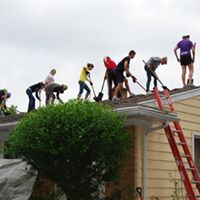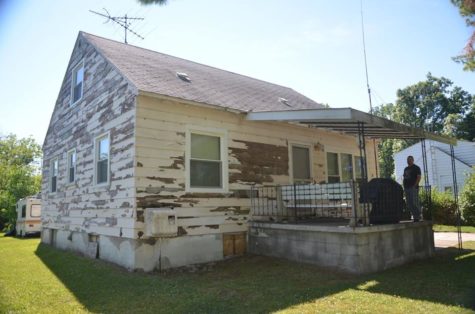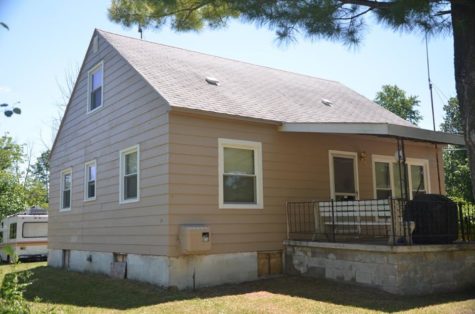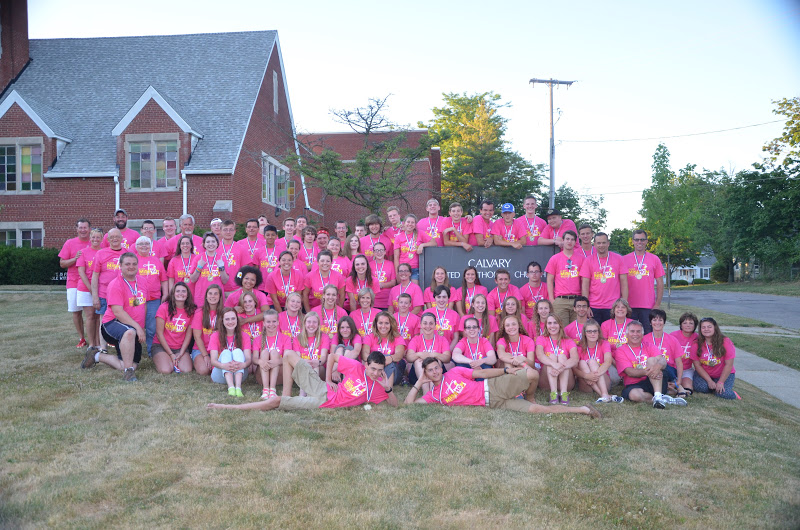Stepping-Stones To Long-Term Service
Huron Valley students make a difference in Flint through mission trip work
Volunteers in front of Calvary United Methodist Church, posing for a group photograph after a long work day.
October 2, 2017
Over the course of the next year, more than 1 million Americans will be involved in short-term mission trips of some sort.
Many of these volunteers are searching for ways to grow and learn, to offer their services, or to try something brand new. Others hope to see the world through a new lens rather than depending on their easy access to a virtual sense of accomplishment, and entertainment at home.
Locally, there are many organizations in charge of mission trips. Jeff Johnson is the short-term mission chairman for Calvary United Methodist Church in downtown Flint, Mich.. Johnson went on two mission tours following Hurricane Katrina, and during one of them a fellow volunteer’s words struck a chord with him. He told Johnson that a person does not need to go across the country, or even across the world, in order to be a missionary or a good Samaritan.
Realizing that he could simply go into his neighborhood to be just as charitable, Johnson felt inspired to do exactly that when he returned home. “That stuck with me, [and] ever since then, I have put all my effort into it,” Johnson explained.
The Flint Mission Project started off as a casual week of 15 volunteers, from all over the state, commuting to Flint, Michigan to provide the struggling city with any help they could offer in 2007. Johnson has since stuck beside his original team to create an official mission trip occurring annually in June.
What started as one man’s passion of helping people has developed into a humbling, and life-changing opportunity for approximately 150 high-school and college age students and their leaders in southeast Michigan. Each year the number of volunteers has risen, as well as the impact that they have on the community of Flint.
When Johnson chose to establish a mission project close to home, he had no idea that doing so would provide hundreds of students with stepping-stones to long-term service.

Recently, the Flint Mission Project had its 11th year anniversary in June. Volunteers have helped 150 houses total, since 2007. By stripping and re-shingling roofs, rebuilding porches, painting exteriors, and repairing and installing drywall, this non-denominational outreach has changed the city and community of Flint forever.
Almost all of the volunteers are dedicated and humble about the work they do in the hurting city, and as Johnson put it: “We always just hear about the bad things young people do, but this just goes to show how many good, young people there are in this world.”
Some of the students choose to see it as a summer camp, where they have a unique opportunity to help people around them. Brent Cohen, a junior at Lakeland High School and volunteer in Flint, expressed that this year, “many connections were made and lives changed. It’s amazing what God can do with a bunch of teens.”
This past year Johnson added a new objective, and freshman Ashleigh Knodel, also from Lakeland High School, excitedly announced its success. “[The volunteers] gave out 6,000 pounds of food in just two hours to the people in Flint and I am so proud to be a part of something that made an impact in not only my life, but in others as well,” she said.

Even excruciating weather doesn’t stop the volunteers from being passionate about the home improvement projects and community outreach they are a part of. In 2012, the workers faced extremely highest temperatures. In the middle of the week the thermometers, on the roof of townsperson Mikasa Brown, read 130 degrees. Teens, guided by experienced adults, were replacing her roof. They managed to keep smiles on their faces as they talked and sang songs. Temperatures may have reached triple digits on the black shingles, “But they all stayed, and it’s just really awesome to help out and give back,” said Johnson.
The hardest part about organizing the trip each year, according to Johnson, is “having the right amount of work to keep everyone busy for the week, but also the right amount that they can finish at the end of the week.”
The application process is another challenge where he struggles. Around 100 homeowners apply every year, and there are certain requirements that they must meet to be considered, including making less than $26,000 a year. Many are desperate for any help they can get, and others are hesitant to admit that they need the help.
“You wouldn’t believe how many people tell me they don’t believe [they deserve our help],” Johnson said. Even Brown, the woman with the damaged roof, was suspicious since she believed that no gift so generous could never be given without paying a price. When Brown finally accepted such a selfless act, she described it as God “showing [her] love and favor.”


Jeff Johnson also works hard to raise the funds that allow him to offer the services without charge. Each volunteer is asked to pay between $100 and $200, for food, supplies, and lodging at Calvary United Methodist Church. A small grant is also often donated by the Methodist District to help Johnson.
The rewards make every obstacle worth it though. Especially when people express their gratitude towards the mission project. One lady from the community of Flint, Theresa Craig, wrote to the volunteers to say that she has “wondered for years why so few people are willing to donate their time, services, and supplies and all work together, taking one house at a time to turn it back to the days of old when the neighborhoods were beautiful and you could walk down the sidewalks, all the lawns were manicured and it was safe.”
Another proud onlooker, Yvonne Girvan, wrote to Jeff Johnson all the way from Wales, UK. She said, “I am the missionary president in the Church of the Nazarene in a small village in North Wales. I am talking in the service tomorrow and I will be sharing the work that our church does in the east side of Flint, Michigan. When I was researching, I came across your projects and I will be telling our congregation of the work your church does as well. May God provide your every need as you bring hope to your community.”
The short term mission, (STM), movement is not a short-lived trend. According to an article on movingmissions.org, “Between 1996 and 2005 the average annual growth rate of people participating in STM was about 27 percent. This rate of growth caused STMs to increase by about 218% during this period.”
Most short-term mission agencies welcome anyone with a caring heart, or a determined spirit. In other words, anyone who genuinely wishes to be involved in construction, medical work, teaching, evangelism, or ministry. It’s practically a cliché now that mission participants receive more than they give, since it is extremely common for volunteers to expect to change the lives of other people, but to find that the process of doing so is a journey of personal growth and faith as well.
German philosopher, Martin Buber, said it well: “All journeys have secret destinations of which the traveler is unaware.” But the world still needs more people to think this way. Not enough people are willing to leave behind their comforts and routines to serve the poor and vulnerable, share the message of the gospel, listen to those who have no voice, and learn from putting other people before themselves.
Therefore, the Flint Mission Project will continue to search for more selfless servants to participate in its contributions and relief in Flint, Michigan for many years to come.
